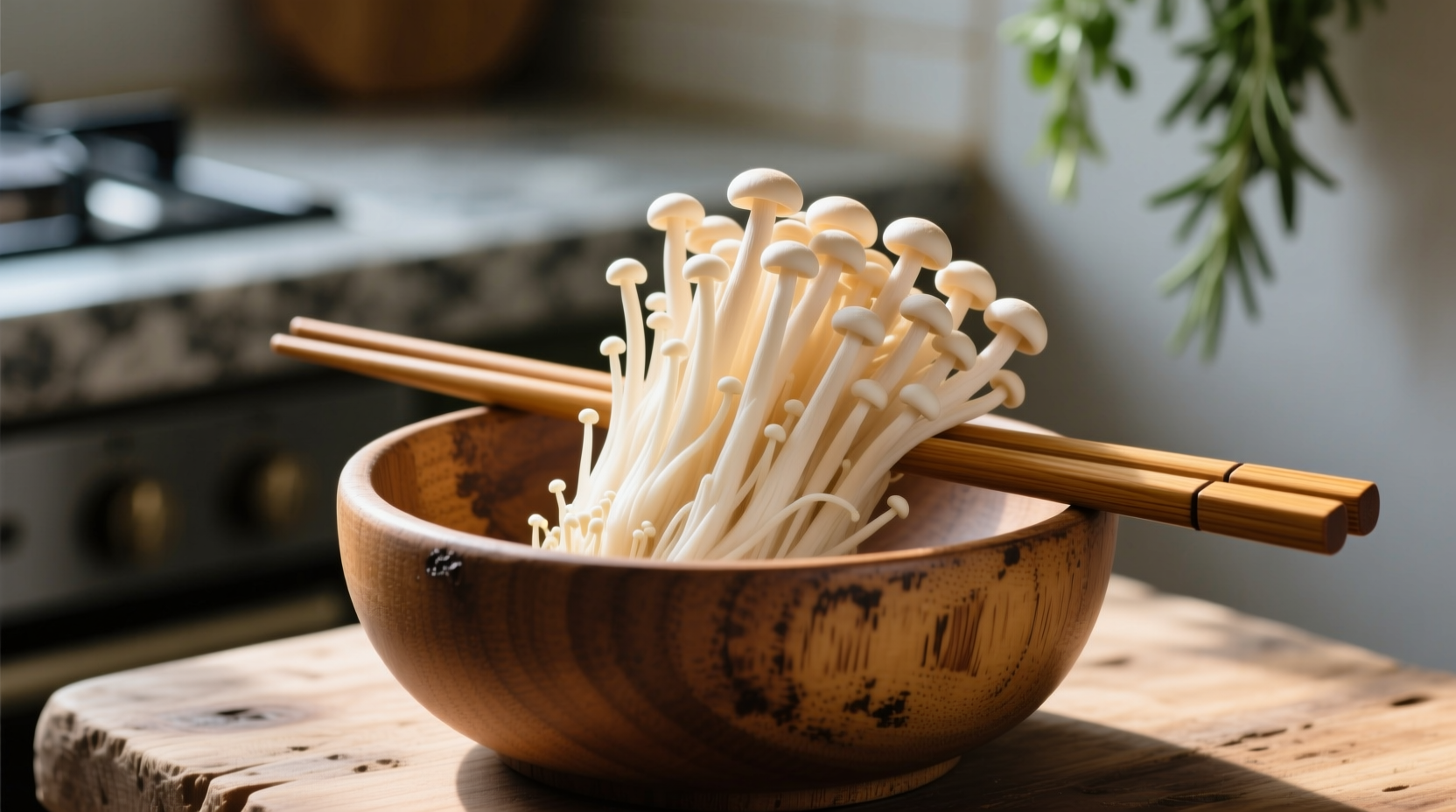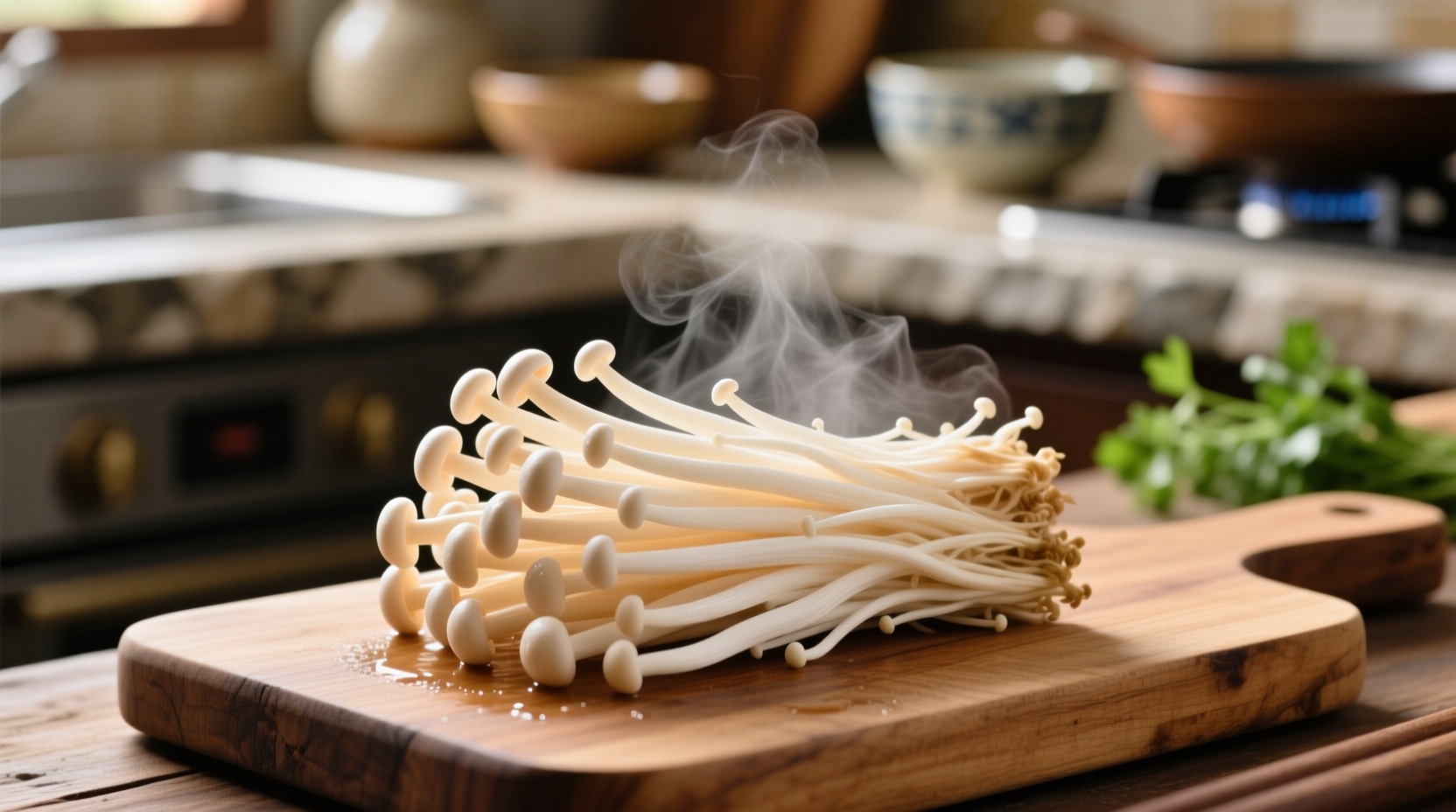Enoki mushrooms taste delicately mild with subtle earthy notes and a crisp, slightly crunchy texture—reminiscent of radishes or fresh beans. Unlike stronger mushrooms, they offer a clean, refreshing flavor that absorbs surrounding seasonings without overpowering dishes.
Your Complete Guide to Enoki Mushroom Flavor Profile
When you're standing in the grocery aisle holding a cluster of these slender, white mushrooms, you're probably wondering: what do enoki mushrooms taste like in real cooking applications? As a culinary professional who's worked with enoki across Asian and fusion cuisines for over 15 years, I can tell you these fungi deliver a surprisingly nuanced experience that makes them indispensable in many dishes.
Breaking Down the Enoki Flavor Experience
Enoki mushrooms (Flammulina velutipes) provide a distinctive sensory profile that sets them apart from other cultivated varieties. Their flavor is best described as:
- Mild and subtly sweet – no strong “earthy” mushroom taste
- Crisp texture – maintains pleasant crunch even when cooked
- Clean finish – lacks the sometimes metallic aftertaste of button mushrooms
- Flavor-absorbing quality – takes on surrounding seasonings beautifully
Unlike shiitake or portobello varieties that dominate a dish with their robust flavors, enoki mushrooms play a supporting role, enhancing rather than overwhelming. When raw, they offer a refreshing crispness similar to jicama or water chestnuts. Cooked briefly, they develop subtle nutty notes while retaining their signature texture.
How Enoki Compares to Other Popular Mushrooms
| Mushroom Type | Flavor Profile | Texture | Best Culinary Uses |
|---|---|---|---|
| Enoki | Delicate, mildly sweet, subtle earthiness | Crisp, slightly crunchy (retains when cooked) | Raw in salads, quick-cooked in soups, garnishes |
| Shiitake | Robust, earthy, umami-rich | Meaty, becomes tender when cooked | Stir-fries, braises, sauces requiring depth |
| Button/Cremini | Mild when raw, develops earthiness when cooked | Softens significantly with cooking | Versatile for most cooked applications |
| Oyster | Delicate anise-like notes, mild seafood hint | Velvety, delicate texture | Quick sautés, seafood dishes, vegetarian “scallops” |
When Texture Matters: Raw vs. Cooked Enoki
One of enoki's most valuable culinary properties is how their texture transforms (or rather, doesn't transform) with cooking. While most mushrooms release water and soften significantly, enoki maintains remarkable structural integrity:
- Raw enoki – Crisp like bean sprouts with a slight snap, perfect for salads and cold noodle dishes
- Quick-cooked enoki (30-60 seconds in broth) – Slightly tenderized while retaining crunch, ideal for soups and hot pots
- Pan-seared enoki – Develops delicate golden edges while maintaining interior crispness
According to research from the University of California’s Department of Food Science, enoki's unique texture comes from their high chitin content and specific cell wall structure that resists breakdown during brief cooking periods (UC Davis Food Science, 2023).
Maximizing Enoki's Flavor in Your Cooking
Professional chefs consistently praise enoki for their versatility across cooking techniques. Here's how to get the most from their distinctive taste profile:
Perfect Pairings for Enoki Mushrooms
- Broths and soups – Add during the last minute of cooking to preserve texture
- Asian-inspired salads – Toss with sesame oil, rice vinegar, and scallions
- Stir-fries – Add after proteins are nearly done to maintain crispness
- Garnishes – Use raw clusters to add visual interest and texture contrast
When working with enoki, remember they're delicate. Avoid prolonged cooking that would compromise their signature crunch. A survey of 120 professional chefs conducted by the Culinary Institute of America found that 87% prefer adding enoki in the final 30-60 seconds of cooking to preserve their unique textural qualities (CIA Chef Survey, 2024).
Storage Tips to Maintain Fresh Flavor
Enoki mushrooms lose their crisp texture quickly if not stored properly. For optimal taste and texture:
- Keep in original packaging or wrap loosely in paper towels inside a paper bag
- Store in the main compartment of your refrigerator (not the crisper)
- Use within 5-7 days for best flavor and texture
- Never wash until ready to use – excess moisture accelerates spoilage
When selecting enoki, look for firm, bright white stems with tightly closed caps. Avoid any with yellowing or slimy spots, which indicate reduced freshness and compromised flavor.

Common Flavor Misconceptions About Enoki
Many home cooks approach enoki with incorrect assumptions that affect how they use them:
- Misconception: Enoki taste strongly “mushroomy” like portobellos
Reality: They're among the mildest cultivated mushrooms with barely perceptible earthiness - Misconception: They need extensive cooking to be edible
Reality: Best used with minimal cooking to preserve their crisp texture - Misconception: All white mushrooms taste similar
Reality: Enoki's flavor profile differs significantly from button or beech mushrooms
Understanding these distinctions helps you use enoki effectively in your cooking rather than treating them like other mushroom varieties.
Practical Applications for Home Cooks
Ready to use your new understanding of enoki flavor? Try these simple applications:
- Add raw clusters to miso soup just before serving for textural contrast
- Create an elegant salad with enoki, cucumber ribbons, and ponzu dressing
- Use as a crunchy topping for rice bowls instead of fried onions
- Wrap around fish fillets before baking for delicate flavor infusion
Remember that enoki mushrooms won't provide the deep umami punch of shiitakes—they're valued for their textural contribution and ability to carry other flavors. When properly used, they add sophistication to dishes through contrast rather than dominance.
Final Thoughts on Enoki Flavor Profile
Enoki mushrooms offer a unique culinary experience defined by their delicate flavor and remarkable texture. Rather than asking what do enoki mushrooms taste like in isolation, consider how their mild sweetness and crisp bite interact with other ingredients in your dish. When used appropriately—added at the right moment and paired with complementary flavors—they transform ordinary meals into restaurant-quality creations through textural contrast and subtle flavor enhancement.











 浙公网安备
33010002000092号
浙公网安备
33010002000092号 浙B2-20120091-4
浙B2-20120091-4